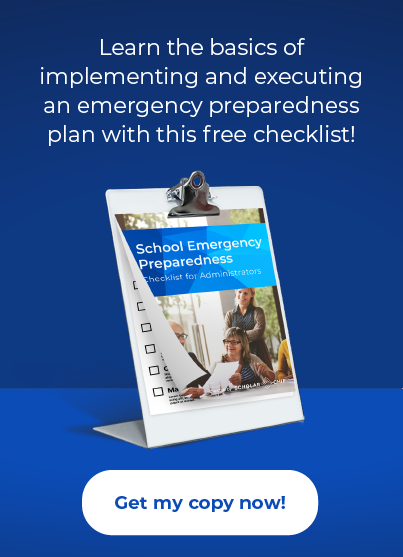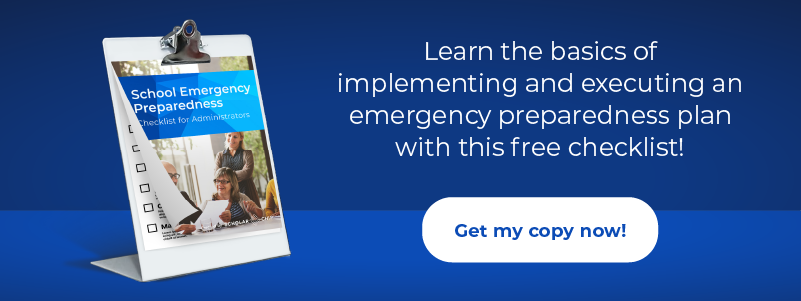The past year has been challenging for everyone. The COVID-19 pandemic has completely upended the way that schools function. Worse, it has increased anxiety and uncertainty for students, parents, staff, and administrators.
When the pandemic hit, many schools didn’t have a complete school emergency preparedness plan in place that could deal with the impacts of COVID-19. It’s critical that you spend the time now to incorporate all the learnings of the previous months into your plan.
If you haven’t updated your plan in a while or if it doesn’t have the right information to deal with recent events, you cannot delay any longer. Your staff, your students, their families, and even the community rely on you to lead the way on disaster preparedness.
When Was the Last Time Your Plan Was Updated?
Most school boards require the creation of a school emergency preparedness plan. However, you may not have the mandate to update it regularly. If you’ve started a new position, you may have inherited an out-of-date plan. Thinking about reviewing and revising your plan may seem like an enormous task.
As recent events have shown, however, updates to address current threats and hazards are crucial for several reasons.
Why an Updated Plan Is So Important
You may be required to have a school emergency preparedness plan, but that document is about far more than just ticking a box.
Why It’s Important to Staff
Having a comprehensive plan in place helps staff feel secure: they know that there is clear direction available should there be a crisis. Essentially, your plan signals to staff that in the event of an emergency, someone is in charge who has thought through the problem.
A plan also provides instruction to your staff on what’s expected of them should something happen. Indecision breeds chaos, and in the midst of an emergency, chaos will only make the situation worse. When your staff knows what to do, they can execute their responsibilities confidently.
Why It’s Important to Students and Families
Students and parents have the expectation that the school will do everything in its power to keep them safe—and rightly so. But when drills are haphazard or disorganized or don’t happen at all, families will question a school’s emergency preparedness.
Communication can also make or break the perception of a school’s readiness. Well-orchestrated and clear communications are critical in a school’s emergency plan. If communication during a standard event isn’t handled well—like during a snowstorm or other common incident—parents will have less confidence in the school’s ability to manage a full-blown crisis.
Student safety at school is top of mind for families, and a lack of confidence in a school’s ability to maintain that safety could have them considering a move to a different school.
Why It’s Important to the Community
A community looks to public institutions like city planning committees, law enforcement, fire departments, and schools to signal the seriousness and planning levels for emergency situations.
When a school doesn’t treat planning as a priority, the community can suffer for it. This further erodes confidence in the competency of a school and its leadership.
How to Start Updating Your School Emergency Plan (and Keep It Updated)
The task of updating such a large and important document can be overwhelming. When doing a complete overhaul of your school emergency preparedness plan, start by reviewing what you already have and noting the obvious holes.
As you review, remember that there should be three points of planning: prevention and preparation, incident management, and post-event action. Your review should also note what new threats aren’t accounted for and where new solutions may help promote safety or reduce risk.
Ask yourself: beyond the immediate safety of your students during an event, what are your goals for this update? Are you looking to improve prevention? Identify new risks? Or do you want better communication with families, staff, and the community?
Next, organize a planning committee. This gives you a group that can help shoulder the burden of updates and makes room for creating a well-rounded plan that includes a multitude of perspectives. Be clear in telling your committee that you’ll need their help and that emergency preparedness is a top priority.
If it’s been a while since you’ve updated your plan, this may be a large and challenging task. To prevent ending up in the same place in the future, set up regular meetings with your team and do updates as needed. By creating a rolling schedule of consistent updates, you’ll be able to manage any immediate changes quickly and keep preparedness planning in the minds of those who help you maintain it.
Your school emergency preparedness plan is vital for reasons far beyond detailing what to do during a tornado or fire. Having a clear and comprehensive strategy gives you the confidence to act in the best interests of your students and staff in the event of an emergency and shows the entire community that the care of the people at your school is your priority.
Updating the plan may seem overwhelming, but the best way to get it done is to get started. Figure out how to divide up tasks in a way that benefits the plan and delegates some of the work, and remember to plan for prevention, incident management, and after-incident response. Your plan will be updated before you know it, and you’ll be ready to face whatever emergency comes your way.
ScholarChip offers holistic school safety services aligned with CDC guidelines to help schools reopen amidst growing health concerns. Through our advanced technology, built and designed for the K-12 environment, schools can identify risks and mitigate the spread of infection. Our solutions include fever screening, visitor surveys, symptom and vaccine tracking, in-school contact tracing, alerts and notifications. Learn more about our advanced COVID-19 solutions or request a reopening strategy session today!


